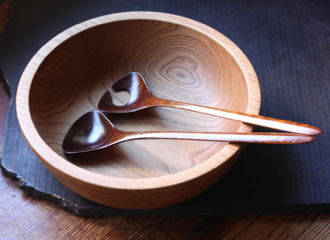

|

|
|
沖神奈川県葉山町で漆作品を作り続ける伏見眞樹さんはhandmadejapan.comでも度々ご紹介してきました。20年程も前から、裏山で切り出した孟宗竹から大小のスプーンを彫り出し始め、今では彼の作品群を代表するものとなっています。 そのスプーンの専門家が ”たからもの”として大切にするのが、故谷口 吏さんの匙。使うのがもったいないほど、色よし、形よし、口触りよし、三拍子揃った木製スプーン。そんなスプーンを作ってきた作家の考え方、生き方を彼の言葉から: ”今日の漆掻きのほとんどが、夏には山で漆掻きをし、冬には町の工場で出稼ぎをしている。僕は拘束されたくなかったので、自分一人でできる冬の仕事を探した。/ 匙を作ると決めたのは、大きな器と違って、匙は初めから終わりまでひとりで作れるからだ。匙は大きな機械も要らないし、自分の手で削り出して、自分の手で集めてきた漆を塗るだけでできる。/ 僕が作っている匙のかたちは、長年、使い手のことを考え、線の美しさを考えて、少しずつ変えたり改良したりしているうちにできたものだ。そのかたちは頭ではなく、僕の手が覚えている。木地の最後の削り出しに使うかんなは、自分の指先くらいの大きさだ。” |
 |

|
|
536本。昨年一年間で作った24種のカトラリーの総本数だ。毎年600本を目標に作っているが、記録が残る2001年からその目標を達成できたのは3回にとどまる。 そもそも私がスプーンを作り始めたのは、漆掻きの谷口吏氏のスプーンを見たのがきっかけだった。今から30年以上前、あるギャラリーで初めて見たそのスプーンに衝撃を受けた。聞けばほとんど機械は使わず、ノミや鉋などの手のひらにおさまる工具だけで削り出したという。そして漆塗りも刷毛目がない完璧な仕上がりだ。思わず「ここまでやるか」とつぶやき、手作りの素朴さが潔いほど残っていないことに感服した。そしてまた、漆掻きという最も自然に対峙する仕事をしている人間が、まるで工業製品のような精緻なスプーンを作るミスマッチにも「手作り」の本質を考えさせられた。 同時にもう一つ驚かされたのはその価格だ。たかがスプーン1本が1万円!自分が1万円のお椀を作っていることは棚に上げて驚いてしまった。でも改めて考えてみると、お椀は木地作りから塗りや磨きまでほとんど電動ろくろを使用できるが、スプーン作りは機械に頼ることができないのではるかに手間がかかる。果たして自分がこれほどクオリティの高いスプーンを1万円で作れるだろうか?仮に1カ月に50本のスプーンを作るとすると50万円の売り上げになるが、それは全て自分が直接販売した場合で、小売店に卸した場合は30万円。つまり1万円でも採算が合うか微妙だ。ではもっと沢山作れば利益をあげられるかもしれない。しかし素材を準備して一から形を削り出し、漆を何回も塗り重ねて仕上げるのだから1カ月に50本作るのが限界。品質を保ちながら年間600本制作することが20年間で3回しかできなかったのも仕方がないかもしれない。 写真のサラダサーバーは谷口氏と自作のお椀を物々交換して手に入れた。実際に使うことはあまりなく、自分が作るスプーンを並べて見劣りしないか、制作の羅針盤となる私の「たからもの」だ。 伏見眞樹
|
|
〈Series: My Treasures〉 "Maki Fushimi's Treasure : Tsutomu Taniguchi's Salad Servers” The total number of 24 cutlery types I handcrafted last year: 536. Although I’ve been crafting cutlery every year with an annual goal of 600 pieces, I’ve been able to achieve that goal only three times since 2001. To begin with, what triggered my desire to create spoons was the experience of seeing spoons crafted by a lacquer tree sap collector named Tsutomu Taniguchi. More than 30 years ago, I was blown away when I saw his spoons at a gallery for the first time. He told me that those spoons were carved out mostly by hand using small tools like chisels and planes, without hardly using a machine. Moreover, the lacquer coat of the spoons was beautifully finished with no brush marks. I couldn’t help but mutter to myself: “I can’t believe he goes to such an extent.” I was deeply impressed by his perfect works, which left absolutely no trace of the simplicity of handmade items. A man whose profession is to collect lacquer tree sap––a job that brings you the closest to nature––makes sophisticated spoons that look like an industrial product; this seemingly unmatching combination made me think about the essence of handcrafting. At the same time, I was also astonished by the price: 10,000 yen for just one spoon! The price surprised me even though the price of my own lacquered wooden bowls was also 10,000 yen! Reflecting on the production processes, I realized that it takes much more effort to handcraft a spoon than a bowl as most of the steps for crafting a lacquered wooden bowl––from carving, coating, to polishing––can be done by electric woodturning tools but machines are useless for the most part of crafting a lacquered wooden spoon. I asked this question to myself: “If I made a spoon of such high quality, would I be able to price it at 10,000 yen?” If I were to make 50 spoons in a month, the sales of the spoons would be 500,000 yen; that is, if I were to directly sell them. If I were to sell them to retailers, the sales would only be 300,000 yen. In other words, it’s a fifty-fifty chance that I would recover the cost even if I priced them at 10,000 yen a piece. If I were to increase the quantity, maybe I would be able to make a profit. But the maximum quantity I can handcraft per month is 50 since I must carve the form out of a wood block and coat the surface with lacquer several times before finishing each spoon. It’s inevitable that, while maintaining quality standards, I’ve only been able to achieve my annual production goal of 600 pieces three times in the past 20 years. The photos show Mr. Taniguchi’s salad servers that came into my possession by trading them with a lacquered wooden bowl I crafted. Hardly used during meals, these salad servers are mostly used to check that my spoons don’t pale in comparison when they are placed next to the servers; Mr. Taniguchi’s salad servers are the compass of my production process, my treasure. |
| (2021/5 よこやまゆうこ) |
|
(C)Copyright 2004 Jomon-sha Inc, All rights reserved. |